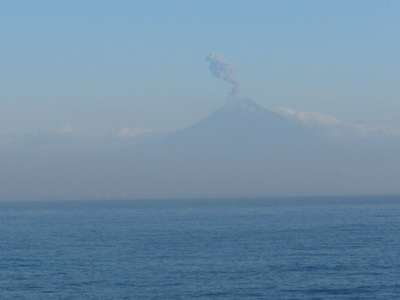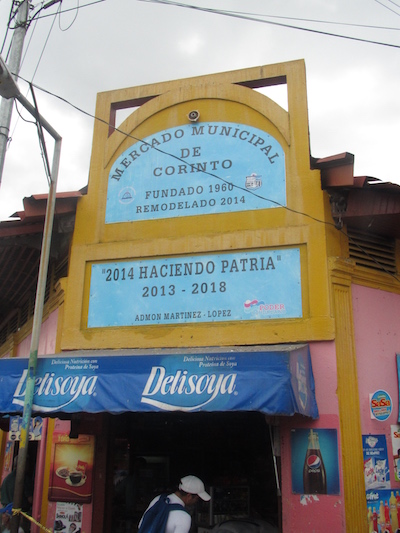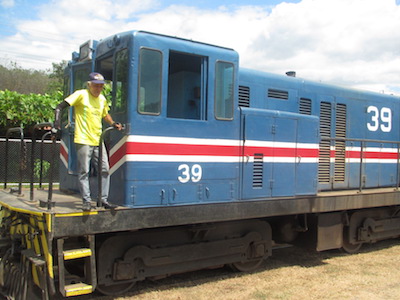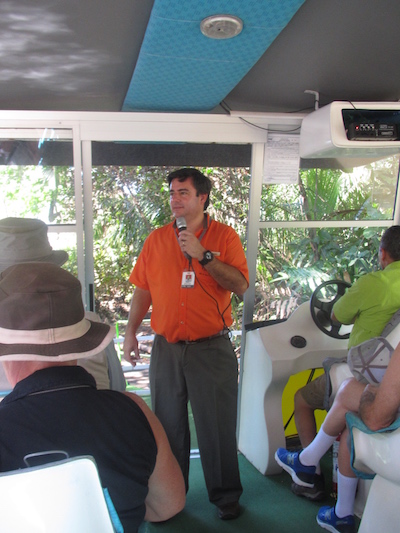
Why do all the excursions take you 90 minutes away (and 90 minutes back)? Because there's nothing nearby that HAL controls?
Rather than go to Antigua with all the other tours, we'll go for a 75-minute bus ride through the country-side to the coffee plantation.
2/3/17 Friday Puerto Quetzal, Guatemala.
Photo Link
Another nice day heading into port.
As I was taking my hike around the deck, I saw a volcano ashore begin erupting. Fascinating to watch it burp out clouds of ashes. It continued doing small eruptions for quite a while.
Then it disappeared in the haze so I watched the ship enter port & dock at a very isolated location in the middle of the industrial port.

The first group left on their tours but ours left a little later so I did some computer work.
Then we departed from the sales places at the pier head. We went NE across the lowlands, then started climbing into the highlands. Coffee trees grow best at altitudes from 3,000 to 6,000 feet in this soil and sunlight. We traveled through some pretty poor towns and districts until we arrived at Finca Columbia (Farm Columbia) outside Antigua. The dormant volcano Agua just to the southeast has given the farm its volcanic soil.
We were greeted and told what we would see and how it would work. After a break we headed off into the coffee trees. Our trainee guide (great-niece of owner) did her best but the owner stepped in when needed.
The farm has just suffered a night of freezing temperatures. Some of the trees are losing their leaves and beans and some may die. The owner has no choice but to harvest all the other beans now, regardless of maturity to save what she can and go on with the farm. The last freeze would have been 30-40 years ago.
There is a volcano close at hand. It sometimes receives and passes on a great deal of water, so there are big ditches to let that large amount pass through. They receive enough for the trees by rain.
The coffee tree is planted with a shade tree. The shade tree grows taller and provides shade for the coffee tree, or it would die of too much sunshine. They actually cut the top off the shade tree to cause it to spread at the top to provide more shade.
We saw the processing that separates the top quality beans from the lower quality. Top quality floats, the rest do not, so a large bath is used to separate them. Then the outer shell is crushed to release the inner beans as they wash down to a collecting area. Then they are taken to the drying floor. About 10 days of processed beans are brought onto the drying floor separately each day and put away each night away from rain and dew.
When dried, they are sold or packaged on the farm for sale.
It was an interesting tour and very comfortable, since we were at 5,000 feet (15*f cooler than sea level). The ride back passed with lots of questions being asked of the bus guide.
Back at the pier-head, D shopped while I went aboard, got my laptop, returned, got onto slow wired internet and uploaded the trip web-site. Yay, finally got it on-line.
It was too early to eat so we went to the Crow's Nest and ordered drinks. We got two of each, it being Happy Hour. Hmmm…..
We got through those two and ate in the Lido because the Dining Room didn't have anything that really interested us. We ran into some Alaskans who live at Dyea, the base of the Chilkoot Trail to Lake Bennet. They run an outpost there. He worked on the WP&Y railroad for 10 years and knew J D True, an engineer who later wrote a couple of interesting books about life on the White Pass & Yukon. They were delegates to the Republican convention in Ohio - rather rabid.
We did the Port & Chocolate tasting later and learned a few things. Biggest lesson is to drink and eat what you like, because no one else can taste what you taste.
And to bed.

2/4/17 Saturday Corinto, Nicaragua
Photos Link
We're not doing any tours today. We'll loaf around the ship, do a little laundry and take a hike into the adjacent town of 23,000 people.
Corinto is named for the city of that name in Spain, which is named for the ancient city-state of Corinth.
We hiked into town around 1100. It's a pitiful place, everything old and run-down, or poorly constructed from corrugated steel roofing. You have to recall the civil war of the 1990's to understand why the economy is not as good as other countries. And there are no resorts here with rich visitors and part-time residents.
Everyone had something they wanted to sell us or do for us. It was sad to be saying No all the time, but if you said Yes all the others would flock around. Even the dogs were terribly thin.
We saw perhaps a dozen Rotterdam passengers wandering around like we were. Our route was out through the industrial gate, two blocks ahead to the park/square. Once around the square taking pictures, then diagonally across the square to our original street. Then back through the industrial gate. I doubt we were in town 30 minutes.
We gave a few bucks to the dancers and players performing on the pier as we re-boarded.
Back on board, we did lunch and then diddled. At 1430, a couple of guests were still not aboard. At 1500 the Captain had the lines singled up and the gangway inboard when the last two showed up.
Underway. Then we listened to a Trivia contest in the Crow's Nest. D went off to church & I had a twofer Gibson for Happy Hour. She came back and we went to dinner with Pinot Noir, then to the cabin to relax and rest.
There, I finally finished my Ken Follett book of some 1265 pages. But we started doing a little rocking-and-rolling so I looked to see what was happening. And found that the wind being felt by the ship at 2100 is from 075*T at 49 knots. Our course is 145*T, speed 16 knots so you vector folks can sort that out. No big deal to us, but I imagine some folks are unhappy with the jarring and rolling.

Photos Link
We docked at the city pier for Puntarenas, rather than the industrial port of Puerto Caldera which some other cruises have done. It didn't make a lot of difference since the downtown started at the head of the pier and there were lots of people on the beach and in the first streets, this being the Sunday before school resumes.
We had pre-booked an interesting-looking train/boat/bus tour. It was done in this sequence: bus, boat, bus, train, bus. We were picked up and dropped back at the ship.
The bus trip seemed a long time. We went out parallel to the ocean then up and over several small hills. Then we went on a gravel bumpy road for what seemed like hours but ended at the tour boat after 75 minutes - the advertised time.

He accompanied us on the boat which held all of us. The boat captain was good at handling the dual-outboard craft on this man-made waterway that is narrow in some spots. We saw ibis, heron, a small crocodile, iguana, macaws, and other things. At the end we were afforded the opportunity to buy things. We picked up a few small items.
The bus took us to the train. Literally. The bus pulled up adjacent to the train car and we walked across a gangway directly onto the train. The train reached a tremendous speed, perhaps 8 or 10 mph. It was limited to that by the bad right-of-way and tracks.
Costa Rica has poured their money into education (all grades free) and health care (free) over the past 20 years with a concurrent decay in infrastructure. There was a Transcontinental railway here, but a bridge collapsed closing it. It was not re-built because the head of government had close ties to trucking, I'm told. So there is no railroad service from Puntarenas to San Jose, but there is a commuter service in San Jose that is going great guns.
The train ran along the top of a ridge for quite a ways, then went down the side of the hill, through a long tunnel and out into the cantaloupe fields. Then we closed in on the towns and transferred back to the bus to take us into town.
The bus ride to the pier revealed a lot of low-income shacks/dwellings, not many middle-class houses and no high-class places (they must be somewhere else).
The cost of living is low here, so Pablo said there is a sizable US ex-pat community all over Costa Rica.
We returned to the cabin, then went to the Lido deck hamburger stand. We took it easy for the afternoon. After getting underway at 1730 we looked at the mountains for a while, then went to dinner. We shared a table with a Canadian couple and a lady from Kalamazoo. The chatting was fun and the food very good, so we really enjoyed it.
And thus comes an end to our exploration of Central American countries. We're at sea for the day tomorrow which we'll document on the Panama Canal page. along with our account of the dash through the canal the next day into the Atlantic.
